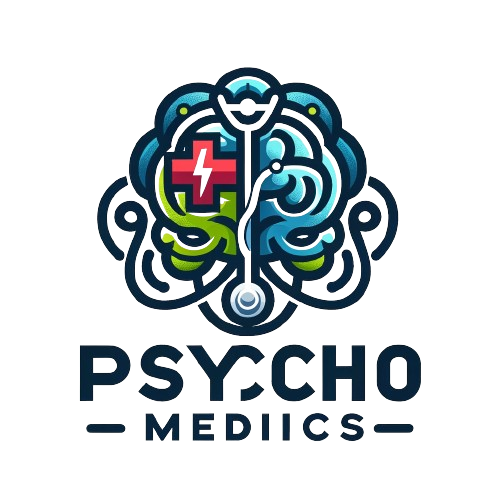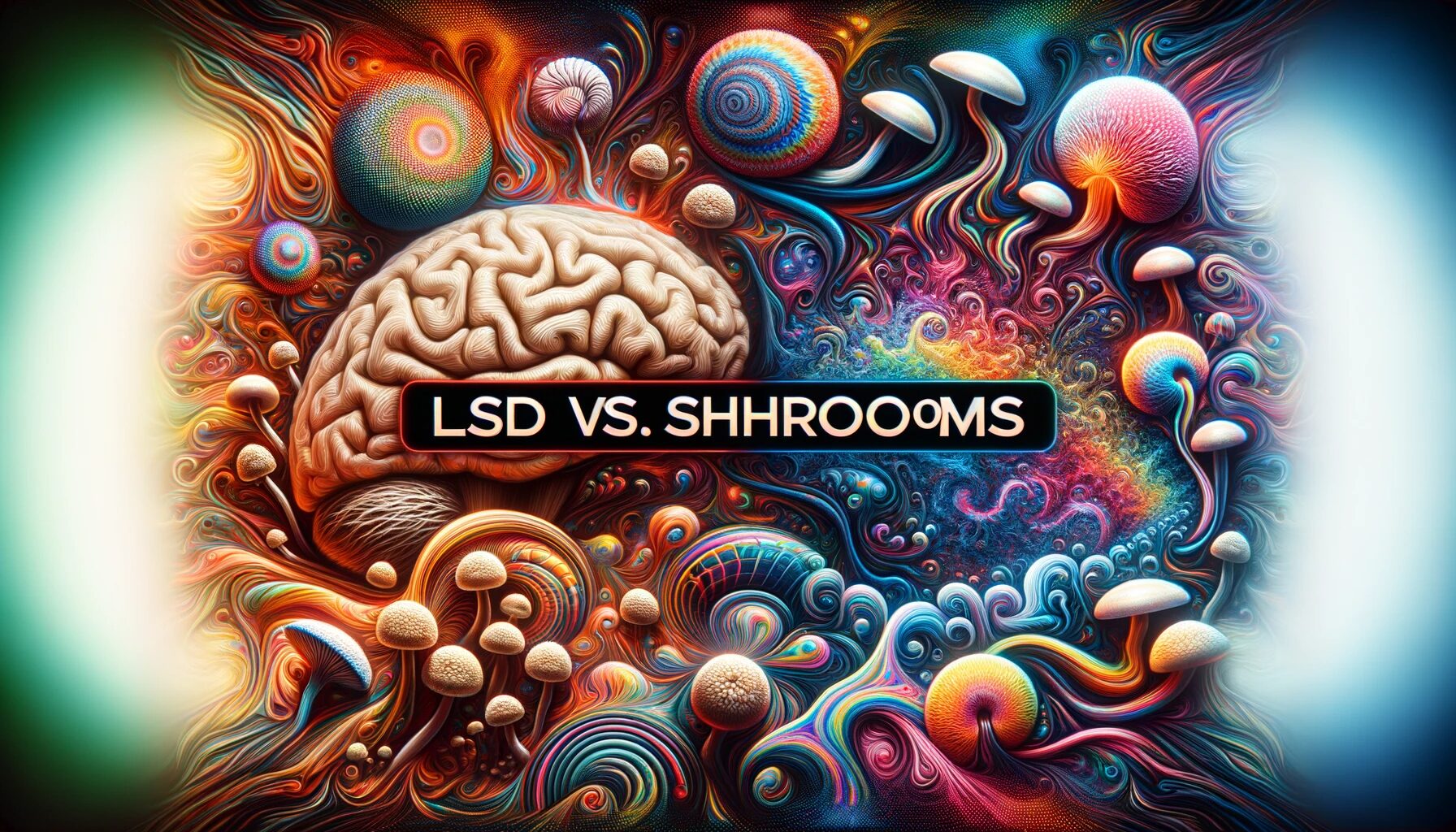In the realm of psychedelic substances, LSD (Lysergic Acid Diethylamide) and Psilocybin Mushrooms (“Shrooms”) stand out as two of the most prominent and widely recognized. Both have a rich history that intersects with culture, psychiatry and the ongoing debate about the nature of consciousness and spiritual experiences. Despite being often mentioned in the same breath due to their psychedelic properties, LSD and shrooms differ significantly in their origins, chemical structures, and the experiences they induce.
LSD, a synthetic compound, was an accidental discovery that came to symbolize the counterculture movement of the 1960s, altering perceptions and expanding minds. In contrast, shrooms, with their naturally occurring psychedelic compound psilocybin, have a much older, shamanic tradition, having been used for centuries in religious and spiritual rituals. Both substances have been the subject of political controversies, legal battles, and intense scientific research, particularly regarding their potential therapeutic benefits and risks.
This comparison between LSD and shrooms aims not only to distinguish their chemical and experiential differences but also to shed light on their potential roles in modern medicine, particularly in mental health treatment. Additionally, we delve into the cultural and historical contexts that have shaped the public’s understanding and acceptance of these powerful substances. As research into psychedelics is experiencing a renaissance, understanding the nuances between LSD and shrooms is more relevant than ever, both for those interested in their therapeutic potential and for broader societal awareness.
In this comprehensive overview, we’ll explore the origins, chemical properties, effects, therapeutic uses, and legal status of LSD and shrooms. This exploration is particularly timely as the scientific community reevaluates the therapeutic potential of psychedelics, challenging longstanding legal and social stigmas. As we embark on this journey, it’s crucial to approach these substances with a balanced perspective, recognizing their powerful capacity to alter human consciousness and the need for informed and respectful use.
Chemical Structure and Source
Understanding the chemical structure and source of LSD and shrooms is crucial for comprehending their distinct effects and interactions within the human body. These differences play a significant role in how these substances are synthesized, their purity, and ultimately, their impact on the user.
LSD (Lysergic Acid Diethylamide)
- Chemical Structure: LSD is a complex, synthetic molecule made up of a combination of carbon, hydrogen, nitrogen, and oxygen atoms. Its chemical structure is known for its unique arrangement of rings, which is critical for its interaction with brain receptors. The structure of LSD is similar to serotonin, a key neurotransmitter, allowing it to bind effectively to serotonin receptors.
- Synthesis: The synthesis of LSD is a complex chemical process that requires advanced knowledge in organic chemistry. It involves synthesizing lysergic acid, which is then converted into LSD. This process is not only intricate but also requires access to specialized chemicals and laboratory equipment.
- Source: LSD is derived from lysergic acid found in ergot, a fungus that grows on rye and other grains. Ergot has a long history of both medicinal use and toxicity; it’s known for causing ergotism, a serious condition, when consumed in large amounts.
Psilocybin Mushrooms (Shrooms)
- Chemical Structure: The primary psychedelic compound in shrooms is psilocybin, which, like LSD, is a complex molecule. However, its structure is different, resembling the neurotransmitter tryptamine more closely. Psilocybin is a prodrug, meaning it’s converted into the active compound psilocin once ingested, which then exerts the psychedelic effects.
- Natural Occurrence: Unlike LSD, psilocybin is not synthesized in a lab but is naturally occurring. It’s found in over 200 species of mushrooms. These mushrooms vary widely in their appearance, potency, and distribution across different climates and geographies.
- Cultivation and Harvesting: Psilocybin mushrooms can be cultivated or harvested in the wild. Cultivation requires specific conditions of humidity, temperature, and light, making it more accessible compared to the synthesis of LSD. The variability in psilocybin content among different species and even within individual mushrooms can lead to unpredictable potency.
Mechanism of Action
The psychedelic experiences induced by LSD and shrooms are primarily the result of their interactions with the brain’s serotonin system, but the specifics of these interactions and their broader effects on brain function are quite distinct.
LSD (Lysergic Acid Diethylamide)
- Interaction with Serotonin Receptors: LSD’s molecular structure is very similar to serotonin, a key neurotransmitter in the brain. This similarity allows LSD to bind to and activate serotonin receptors, particularly the 5-HT2A receptor. The activation of this receptor is crucial for the psychedelic effects of LSD.
- Effects on Brain Connectivity: Research shows that LSD leads to increased connectivity between different regions of the brain. This can result in the breakdown of normal boundaries between the sense of self and the external world, leading to experiences commonly referred to as “ego dissolution” or “oceanic boundlessness.”
- Long Duration of Action: LSD has a unique property of being trapped within the 5-HT2A receptor due to its molecular shape. This trapping leads to a prolonged stimulation of the receptor, which contributes to the long duration of LSD’s effects, typically ranging from 8 to 12 hours.
Psilocybin Mushrooms (Shrooms)
- Conversion to Psilocin: Once ingested, psilocybin is converted into psilocin, the compound that is actually responsible for the psychedelic effects. Psilocin, like LSD, acts on serotonin receptors, with a preference for the 5-HT2A receptor.
- Differences in Brain Connectivity: While shrooms also enhance brain connectivity, the pattern is somewhat different from LSD. Psilocybin has been shown to decrease activity in certain areas of the brain, such as the default mode network (DMN), which is associated with self-referential thoughts and mind wandering. This decrease can lead to a sense of ego dissolution, similar to LSD, but through a slightly different neural pathway.
- Shorter Duration and Variable Effects: The effects of psilocybin last for a shorter period compared to LSD, typically around 4 to 6 hours. The experience can vary significantly depending on the dose, individual psychology, and environment, often described as more emotional and less visually stimulating than LSD.
Mechanism of Action
The psychedelic experiences induced by LSD and shrooms are primarily the result of their interactions with the brain’s serotonin system, but the specifics of these interactions and their broader effects on brain function are quite distinct.
LSD (Lysergic Acid Diethylamide)
- Interaction with Serotonin Receptors: LSD’s molecular structure is very similar to serotonin, a key neurotransmitter in the brain. This similarity allows LSD to bind to and activate serotonin receptors, particularly the 5-HT2A receptor. The activation of this receptor is crucial for the psychedelic effects of LSD.
- Effects on Brain Connectivity: Research shows that LSD leads to increased connectivity between different regions of the brain. This can result in the breakdown of normal boundaries between the sense of self and the external world, leading to experiences commonly referred to as “ego dissolution” or “oceanic boundlessness.”
- Long Duration of Action: LSD has a unique property of being trapped within the 5-HT2A receptor due to its molecular shape. This trapping leads to a prolonged stimulation of the receptor, which contributes to the long duration of LSD’s effects, typically ranging from 8 to 12 hours.
Psilocybin Mushrooms (Shrooms)
- Conversion to Psilocin: Once ingested, psilocybin is converted into psilocin, the compound that is actually responsible for the psychedelic effects. Psilocin, like LSD, acts on serotonin receptors, with a preference for the 5-HT2A receptor.
- Differences in Brain Connectivity: While shrooms also enhance brain connectivity, the pattern is somewhat different from LSD. Psilocybin has been shown to decrease activity in certain areas of the brain, such as the default mode network (DMN), which is associated with self-referential thoughts and mind wandering. This decrease can lead to a sense of ego dissolution, similar to LSD, but through a slightly different neural pathway.
- Shorter Duration and Variable Effects: The effects of psilocybin last for a shorter period compared to LSD, typically around 4 to 6 hours. The experience can vary significantly depending on the dose, individual psychology, and environment, often described as more emotional and less visually stimulating than LSD.
Therapeutic Uses
The potential therapeutic applications of LSD and shrooms are a subject of increasing interest in the field of psychiatry and neurology. Both substances have shown promise in treating various mental health disorders, but their mechanisms of action and the nature of their therapeutic effects differ in significant ways.
LSD (Lysergic Acid Diethylamide)
- Mental Health Disorders: LSD has been explored as a treatment for a range of conditions, including depression, anxiety, and PTSD. Its ability to induce profound psychological experiences can lead to significant shifts in perspective and attitude, which can be therapeutic for individuals with these conditions.
- Psychotherapy Enhancement: LSD is being studied as a tool to enhance psychotherapy. The altered state of consciousness it induces can help patients break free from rigid thought patterns and explore their emotions and memories from a new perspective.
- Cluster Headaches: Interestingly, LSD has also been reported to be effective in treating cluster headaches, a condition known for its extremely painful episodes. The exact mechanism of action in this context is not fully understood, but it’s believed to involve serotonin modulation.
Psilocybin Mushrooms (Shrooms)
- Depression and Anxiety: Like LSD, psilocybin has shown potential in treating depression and anxiety, particularly in cases resistant to conventional treatments. The psilocybin experience can provide patients with profound insights and emotional release that have long-term positive effects on mental health.
- End-of-Life Distress: Psilocybin has been notably effective in reducing depression and anxiety in patients with life-threatening cancer diagnoses. The substance can help these individuals confront their fears about death and find a sense of peace.
- Addiction Treatment: Research into psilocybin as a treatment for addiction (including tobacco and alcohol dependence) is promising. The substance seems to help break the cycle of addiction by providing deep personal insights and a transformative psychological experience.
Legal Status and Safety
The legal status and safety profiles of LSD and Psilocybin Mushrooms (Shrooms) are complex and vary significantly across different countries. Understanding these aspects is essential for both potential users and policymakers.
LSD (Lysergic Acid Diethylamide)
- Legal Status: LSD is classified as a Schedule I substance under the United States Controlled Substances Act and is similarly controlled in many other countries. This classification indicates a high potential for abuse, a lack of accepted safety for use under medical supervision, and no currently accepted medical use.
- Safety Concerns: LSD is considered non-addictive and has a low toxicity relative to dose. However, it can cause intense psychological effects, which can be disturbing or harmful, especially in individuals with a history of mental illness. The risk of what is known as a “bad trip” – a distressing psychedelic experience – is a significant concern, as is the potential for triggering or exacerbating psychiatric conditions.
Psilocybin Mushrooms (Shrooms)
- Legal Status: Shrooms are also typically classified as Schedule I substances in many countries. However, there has been a recent movement towards decriminalization and medical use in some areas. For instance, several cities in the United States have decriminalized the possession of psilocybin mushrooms, and clinical trials are underway to explore their therapeutic potential.
- Safety Concerns: Psilocybin is generally considered safe when used responsibly. It is non-addictive and has a low physiological toxicity. However, like LSD, it can produce intense psychological effects, which can be challenging to manage, especially for those with underlying mental health conditions. The variability in the concentration of psilocybin in different mushroom species also adds a layer of unpredictability to its use.
Comparison and Considerations
- Safety Profile: Both LSD and shrooms are considered relatively safe in terms of physical health, with low potential for addiction and overdose. The primary risks associated with both are psychological.
- Potential for Therapeutic Use: Despite their current legal status, both LSD and shrooms are undergoing a renaissance in scientific research, exploring their potential as therapeutic agents, particularly for mental health disorders. This research challenges the traditional view of these substances and may lead to changes in legal status in the future.
- Importance of Setting and Guidance: For both substances, the importance of the setting (“set and setting”) in which they are used, as well as guidance from experienced individuals, can significantly influence the experience and mitigate risks.
- Legality and Access: The legality of both substances remains a major barrier to access, even for therapeutic purposes. However, the shifting landscape of drug policy, influenced by ongoing research and changing public attitudes, suggests potential changes in the future.
Conclusion
The exploration of LSD (Lysergic Acid Diethylamide) and Psilocybin Mushrooms (Shrooms) reveals a fascinating contrast between two of the most prominent psychedelics. Both substances, while illegal under current laws in many countries and possessing risks primarily related to psychological effects, have shown significant potential for therapeutic use. This potential is leading to a renaissance in scientific research and a gradual shift in public perception and policy.
LSD, with its synthetic origins and longer-lasting, intense experiences, and shrooms, with their natural occurrence and more emotionally grounded effects, offer unique insights into the human psyche. They challenge conventional views of consciousness, mental health treatment, and our understanding of the mind.
The ongoing research into these substances is not just about exploring new therapeutic avenues for mental health disorders, but also about redefining our relationship with these once-stigmatized substances. For detailed information on the legal status and health implications of LSD and Psilocybin Mushrooms, you can visit the National Institute on Drug Abuse website, which provides comprehensive resources and updates on these substances National Institute on Drug Abuse.
As the legal and medical landscapes continue to evolve, it’s crucial for individuals to approach these substances with respect, caution, and an informed understanding of their effects. The future of LSD and shrooms, whether as tools for psychological exploration or as therapeutic agents, seems poised to play a significant role in our ongoing quest to understand and treat the complexities of the human mind.
In summary, the comparison of LSD and shrooms underscores a broader narrative about the reevaluation of psychedelics in society. It’s a narrative that blends history, science, and a growing acknowledgment of the intricate relationship between our brain chemistry and our experiences of the world. As this field advances, it holds the promise of not only new treatments for mental illness but also a deeper understanding of the vast landscape of human consciousness.
FAQs
Q1: What are LSD and Psilocybin Mushrooms?
- A1: LSD (Lysergic Acid Diethylamide) is a synthetic psychedelic drug, while Psilocybin Mushrooms, commonly known as “Shrooms,” are a type of mushroom containing the naturally occurring psychedelic compound psilocybin.
Q2: How do LSD and Shrooms differ in their effects?
- A2: LSD typically produces longer-lasting effects (up to 12 hours), often with intense visual hallucinations and deep thought processes. Shrooms tend to have a shorter duration (4-6 hours) and are often described as offering a more emotional and introspective experience.
Q3: Are LSD and Shrooms safe to use?
- A3: Both substances are generally considered safe in terms of physical health, with low toxicity and low potential for addiction. However, they can cause intense psychological effects, which can be challenging, particularly for individuals with a history of mental health issues.
Q4: Can LSD and Shrooms be used for therapeutic purposes?
- A4: Yes, both are currently being researched for their potential therapeutic benefits, particularly for mental health disorders like depression, anxiety, and PTSD. However, this use is still in the experimental stage and should only be undertaken under professional guidance.
Q5: What is the legal status of LSD and Shrooms?
- A5: In most countries, both LSD and shrooms are classified as Schedule I substances, indicating a high potential for abuse and no accepted medical use. However, there’s a growing movement towards reevaluating this status, especially as research uncovers their potential therapeutic benefits.
Q6: How do LSD and Shrooms affect the brain?
- A6: Both substances primarily affect the brain’s serotonin receptors, leading to altered perceptions and thought processes. LSD tends to cause increased connectivity between brain regions, while shrooms can decrease activity in areas like the default mode network, affecting ego perception.
Q7: Can LSD and Shrooms lead to addiction?
- A7: Both LSD and shrooms are considered to have a low potential for addiction. The primary risks associated with their use are psychological, not physical dependence.
Q8: What should one consider before using LSD or Shrooms?
- A8: It’s crucial to consider the legal risks, as well as personal mental health history. Being in a safe, controlled environment and having a sober, experienced guide can significantly impact the experience’s safety and quality.

Alex is a seasoned writer and researcher, specializing in psychedelic studies and mental health. Known for insightful and authoritative content, he combines extensive knowledge with a passion for exploring wellness and alternative therapies. Alex’s work is a trusted resource for readers delving into the world of mental well-being.


Leave a Reply